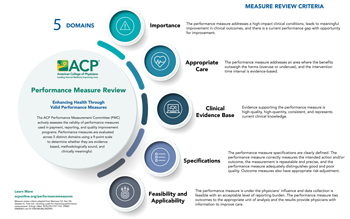Click to expand view.
ACP is working actively in the field of performance measurement because we recognize its importance in the changing health care environment and want to shape its impact on Internal Medicine. The Performance Measurement Committee oversees the College's activities in this area.
The Performance Measurement Committee (PMC) applies criteria to assess the validity of performance measures for healthcare. The criteria are evaluated with a modified RAND-UCLA appropriateness method to determine whether they are evidence-based, methodologically sound, and clinically meaningful.
Latest Performance Measurement Committee Papers
ACP develops clinical policy papers and performance measurement commentaries published in scientific journals to educate ACP members about performance measurement initiatives.
- Quality Indicators for Diabetes in Adults (Annals of Internal Medicine, 2025)
- The Nuances of Performance Measurement and Clinical Guidelines (Annals of Internal Medicine, 2024)
- Quality Indicators for Pain in Adults (Annals of Internal Medicine, 2024)
- Quality Indicators for Major Depressive Disorder in Adults (Annals of Internal Medicine, 2024)
- Quality Indicators for Osteoporosis in Adults (Annals of Internal Medicine, 2023)
- Performance Measures for Physicians Providing Clinical Care Using Telemedicine (Annals of Internal Medicine, 2023)
- Recommending Caution in Patient-Reported Outcome–Based Performance Measurement (Annals of Internal Medicine, 2021)
- Time Out -- Charting a Path for Improving Performance Measurement (New England Journal of Medicine, 2018)
Help Us Improve Performance Measures
The PMC recognizes the burdens that inadequate measures can create for physicians. We are committed to continually reviewing and improving these measures to better support internal medicine physicians and drive meaningful change.
We value your input. Please take a minute to complete a brief survey
PMC Measure Reviews
This tool has been created to help you filter the reviewed performance measures.
= ACP Supports This Measure
= ACP Does Not Support This Measure: Uncertain Validity
= ACP Does Not Support This Measure
= ACP Does Not Support This Measure: Not Tested
Recent Measure Reviews
- Health Plan
Use of Opioids at High Dosage in Persons Without Cancer
The proportion (XX out of 1,000) of individuals without cancer receiving prescriptions for opioids with a daily dosage greater than 120mg morphine equivalent dose (MED) for 90 consecutive days or longer
Date Reviewed: May 11, 2023
- Health Plan
Use of Opioids from Multiple Providers in Persons without Cancer
The proportion (XX out of 1,000) of individuals without cancer receiving prescriptions for opioids from four (4) or more prescribers AND four (4) or more pharmacies.
Date Reviewed: May 11, 2023
- Health Plan
Use of Opioids from Multiple Providers and at High Dosage in Persons without Cancer
The proportion (XX out of 1,000) of individuals without cancer receiving prescriptions for opioids with a daily dosage greater than 120mg morphine equivalent dose (MED) for 90 consecutive days or longer, AND who received opioid prescriptions from four (4) or more prescribers AND four (4) or more pharmacies.
Date Reviewed: May 11, 2023
- Health Plan
Use of Imaging Studies for Low Back Pain
The percentage of patients with a primary diagnosis of low back pain who did not have an imaging study (plain X-ray, MRI, CT scan) within 28 days of diagnosis
Date Reviewed: May 11, 2023
- Health Plan
Concurrent Use of Opioids and Benzodiazepines (COB)*
The percentage of individuals 18 years and older with concurrent use of prescription opioids and benzodiazepines during the measurement year.
Date Reviewed: May 11, 2023
- Group/Practice
- Individual Clinician
Ambulatory Palliative Care Patients’ Experience of Receiving Desired Help for Pain
The percentage of patients aged 18 years and older who had an ambulatory palliative care visit and report getting the help they wanted for their pain from their palliative care provider and team within 6 months of the ambulatory palliative care visit.
Date Reviewed: May 11, 2023


